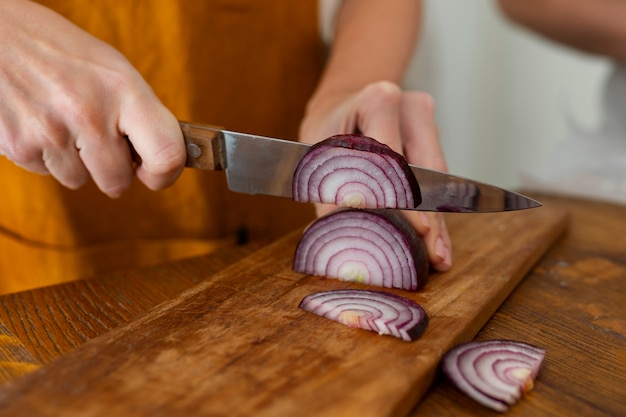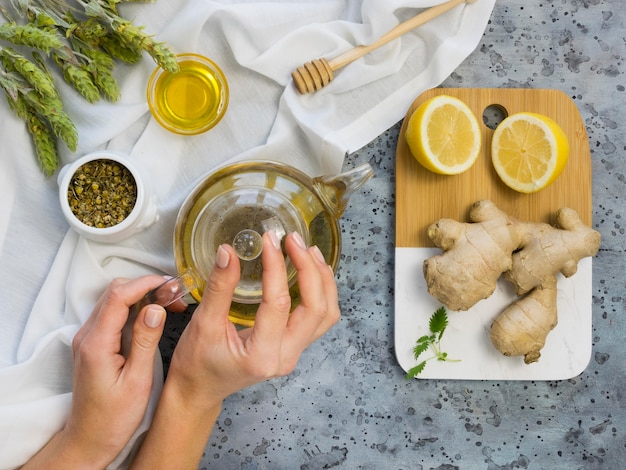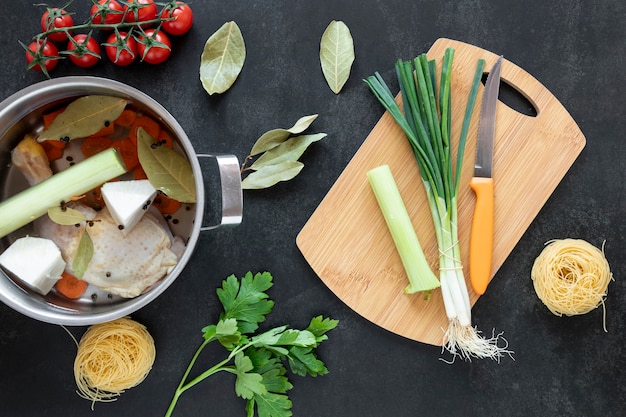Let's be honest, turnips haven't always been the star of the show. They're often relegated to the corner of the vegetable drawer, overlooked for their flashier cousins. But I'm here to tell you that's a real shame! Turnips are a versatile, delicious, and surprisingly adaptable root vegetable that deserves a place on your dinner table.
From my childhood memories of Mum's comforting mashed turnip alongside roast dinners to discovering a whole world of turnip recipes – from hearty stews to vibrant salads, even sweet treats – I've come to appreciate the true potential of this humble root.
Join me on a journey to discover the hidden gems of the turnip world. We'll explore its history, learn how to select the best turnips, delve into various cooking techniques, and even uncover some surprising uses for this delightful vegetable. Get ready to ditch those preconceptions and embrace the turnip's unique charm!
(Part 1) The Turnip's Journey: A Bit of History

Turnips have a long and fascinating history, dating back thousands of years. Their story is intertwined with human history, reflecting our evolving relationship with food and cultivation.
Ancient Origins and Global Reach
Evidence suggests that turnips were cultivated as far back as 4,000 years ago, in ancient civilizations like those in Egypt and Greece. They were a vital part of their diets, providing a reliable source of sustenance. Over time, turnips spread throughout the globe, becoming a staple food in many cultures.
In Europe, turnips are deeply rooted in culinary traditions. You'll find them in classic dishes like the Scottish "neeps and tatties," a comforting pairing of mashed turnips and potatoes, or the French "navets à la crème," a creamy and decadent preparation. Across Asia, turnips are frequently featured in stir-fries, soups, and other traditional dishes. And even in North America, turnips hold a place at Thanksgiving tables, reminding us of their global appeal.
A Symbol of Resilience and Adaptation
The turnip's journey reflects its resilience and adaptability. It can thrive in a variety of climates and soil conditions, making it a valuable food source, even in challenging times. This hardiness earned it a reputation as a symbol of resilience and determination, particularly during periods of scarcity and famine.
From ancient times to the present, turnips have consistently played a crucial role in sustaining communities. Their history is a testament to their versatility, cultural significance, and enduring appeal.
(Part 2) Choosing the Perfect Turnip

Now that we've delved into the turnip's history, it's time to get practical! Choosing the right turnips is essential for unlocking their full potential. Think of it as finding the perfect ingredient for your culinary masterpiece.
Size, Shape, and Colour
When selecting turnips, look for medium-sized ones with a firm texture and smooth, unblemished skin. Avoid overly large turnips or those with soft spots. A good turnip will have a vibrant white or pale yellow colour, indicating freshness and good quality.
Texture and Smell
Give your chosen turnips a gentle squeeze. They should feel firm and springy to the touch. If they feel soft or mushy, it's a sign that they're not as fresh. And remember, a fresh turnip should have a slightly sweet aroma.
Storage Matters
Once you've picked out your perfect turnips, proper storage is crucial for preserving their freshness. The crisper drawer of your refrigerator is the ideal spot. Store them in a plastic bag or wrapped in paper towels to prevent them from drying out. With proper storage, your turnips will stay fresh for about a week or two.
(Part 3) Cleaning and Preparing Turnips

With your perfect turnips in hand, let's get them ready for cooking. It's a simple process, but a few key steps make all the difference.
A Gentle Scrub
Start by giving your turnips a thorough scrub under cold running water. This removes any dirt or debris that may be clinging to the skin. Use a vegetable brush for a more thorough cleaning.
Trimming and Peeling
Use a sharp knife to trim off the top and bottom of the turnip. You can also trim away any damaged or bruised areas of the skin.
Peeling or not? That's the question! Some prefer to peel their turnips for a smoother texture, while others leave the skin on for a slightly earthy flavour and texture. If you choose to peel, be sure to use a sharp peeler and avoid peeling too deeply, as the skin is packed with nutrients.
Cutting and Slicing Techniques
Once your turnips are cleaned and prepped, you can start cutting them into the shapes and sizes your recipe requires. For roasting, wedges or cubes are ideal. For soups and stews, small dice are perfect. And for salads, thin slices, either made with a mandoline or a sharp knife, add a delightful crunch.
(Part 4) roasted turnips: A Simple and Delicious side dish
Roasting is a simple and effective way to bring out the turnip's natural sweetness and create a caramelized, delicious flavour. It's a fantastic side dish for any meal.
The Classic Roasted Turnip Recipe
For this simple recipe, you'll need:
- 1 kg turnips, peeled and cut into wedges
- 2 tbsp olive oil
- 1 tsp salt
- 1/2 tsp black pepper
Preheat your oven to 200 degrees Celsius (400 degrees Fahrenheit). Toss the turnip wedges with olive oil, salt, and pepper. Spread them in a single layer on a baking sheet. Roast for 20-25 minutes, or until tender and slightly caramelized.
Adding Flavor and Variety
Don't be afraid to get creative with your roasted turnips!
- Spice it Up: Add a touch of garlic powder, onion powder, paprika, or a pinch of cayenne pepper for a little heat.
- Sweet and Tangy Glaze: A splash of balsamic vinegar or honey in the roasting pan creates a tangy-sweet glaze.
- Roasted Vegetable Medley: Roast your turnips alongside other root vegetables like carrots, potatoes, or sweet potatoes for a vibrant and satisfying side dish. Just adjust the roasting time accordingly.
(Part 5) Creamy turnip mash: A Comforting Classic
Mashed turnips are a quintessential comfort food, evoking memories of warm kitchens and hearty meals. They're soft, creamy, and perfect for pairing with roast dinners or serving as a satisfying side dish.
The Basic Mashed Turnip Recipe
For this simple recipe, you'll need:
- 1 kg turnips, peeled and diced
- 1 tbsp butter
- 1/2 cup milk
- Salt and pepper to taste
Boil the diced turnips in salted water until tender, about 15-20 minutes. Drain the turnips and mash them with the butter, milk, salt, and pepper. For extra richness, add a splash of cream or a dollop of sour cream.
Mashed Turnip Variations: Taking it to the Next Level
Mashed turnips are a blank canvas for culinary creativity. Here are a few ideas for elevating your mashed turnip game:
- Herby Mash: Add chopped fresh parsley, chives, or dill for a fragrant and fresh touch.
- Spicy Mash: A pinch of cayenne pepper or a sprinkle of chili flakes adds a touch of heat.
- Cheesy Mash: Stir in some grated cheddar, Gruyère, or Parmesan cheese for a savory and satisfying twist.
Remember, there's no right or wrong way to make mashed turnips. Experiment with different flavors and textures until you find your perfect combination.
(Part 6) turnip soup: A Warm and Wholesome Meal
Turnip soup is a warm and comforting meal that's perfect for a chilly day. It's packed with nutrients and flavor, making it a satisfying and wholesome choice.
A Simple Turnip Soup Recipe
For this basic recipe, you'll need:
- 1 kg turnips, peeled and diced
- 1 onion, chopped
- 2 tbsp olive oil
- 4 cups vegetable broth
- Salt and pepper to taste
Sauté the onion in olive oil until softened. Add the diced turnips and cook for 5-7 minutes, or until they start to soften. Pour in the vegetable broth and bring to a boil. Reduce heat to low and simmer for 20 minutes, or until the turnips are very tender. Season with salt and pepper to taste. Use an immersion blender or a regular blender to blend the soup until smooth.
Enhancing Your Turnip Soup: Flavorful Additions
Ready to take your turnip soup to the next level? These additions add depth and complexity:
- Bacon or Ham: Fry some bacon or ham and add it to the soup for a smoky and savory flavour.
- Cream or Yogurt: Stir in some heavy cream or Greek yogurt for a creamy, luxurious texture.
- Herbs: Fresh herbs like thyme, rosemary, or parsley add a fragrant and aromatic touch.
- Spices: Experiment with spices like cumin, coriander, or ginger for an extra layer of warmth and complexity.
(Part 7) turnip fritters: A Savoury Snack
Looking for a fun and flavorful way to use up leftover turnips? Turnip fritters are a delightful and satisfying solution. They're crispy on the outside, soft on the inside, and make a perfect snack or appetizer.
The Turnip Fritter Recipe
For this recipe, you'll need:
- 2 cups grated turnips
- 1/2 cup all-purpose flour
- 1/4 cup grated Parmesan cheese
- 1 egg, beaten
- 1/4 cup chopped fresh parsley
- Salt and pepper to taste
- Olive oil for frying
Combine the grated turnips, flour, Parmesan cheese, egg, parsley, salt, and pepper in a bowl. Mix well. Heat the olive oil in a large skillet over medium heat. Drop spoonfuls of the turnip mixture into the hot oil. Cook for 2-3 minutes per side, or until golden brown and crispy. Serve hot with a dollop of sour cream or a sprinkle of fresh herbs.
Fritter Variations: Expanding Your Options
Turnip fritters are a blank canvas for culinary creativity. Here are a few variations:
- Spiced Fritters: Add a pinch of cayenne pepper, cumin, or coriander to the batter for a spicy kick.
- Cheesy Fritters: Use more cheese in the batter, or add some shredded cheddar or mozzarella for extra cheesy goodness.
- Herby Fritters: Use different herbs like chives, dill, or oregano in the batter.
- Autumn Salad: Combine thinly sliced turnips with kale, apples, walnuts, and a maple-mustard vinaigrette.
- Winter Salad: Toss together thinly sliced turnips, roasted beets, goat cheese, and a balsamic vinaigrette.
- Spring Salad: Combine thinly sliced turnips, asparagus, strawberries, and a lemon-herb vinaigrette.
- Turnip Jam: Combine cooked, mashed turnips with sugar, lemon juice, and spices to create a delicious and unique jam.
- Turnip Pie: Use cooked and mashed turnips as a filling for a sweet pie crust. Add spices like cinnamon, nutmeg, and ginger for extra flavour.
- Turnip Pudding: Combine cooked, mashed turnips with eggs, milk, and sugar to make a comforting pudding.
- Vitamin C: An antioxidant that supports immune function and collagen production.
- Vitamin K: Important for blood clotting and bone health.
- Potassium: Helps regulate blood pressure and muscle function.
- Fiber: Promotes digestive health and helps you feel full.
- Antioxidants: Help protect your cells from damage caused by free radicals.
- Improved Digestion: The fiber in turnips helps promote regularity and healthy digestion.
- Lowered Blood Pressure: Potassium in turnips can help regulate blood pressure.
- Reduced Risk of Chronic Diseases: The antioxidants in turnips can help protect against chronic diseases like heart disease and cancer.
- Boosted Immunity: Vitamin C in turnips helps support immune function.
No matter what variation you choose, these turnip fritters are sure to impress!
(Part 8) Turnips in Salads: A Crunchy Addition
Turnips aren't just for stews and soups! They add a delightful crunch and subtle sweetness to salads, creating a unique textural element.
Incorporating Turnips into Salads
To add turnips to your salads, simply slice them thinly using a mandoline or a sharp knife. You can use them in your favorite salad recipes or create a whole new salad featuring this versatile ingredient.
Salad Inspiration: Turnip-Based Salad Ideas
Here are a few salad ideas to inspire your turnip-filled creativity:
Remember to adjust the vinaigrette based on the other ingredients in your salad. A tangy or citrusy vinaigrette complements the turnip's sweetness beautifully.
(Part 9) Turnips in Desserts: A Sweet Surprise
You might be surprised to learn that turnips can be used in desserts! Their sweetness and texture make them a unique and delicious addition to sweet treats.
Turnip Cake: A Savoury Delight
Turnip cake, a popular dish in many Asian cultures, is a savoury cake often served during special occasions. The turnips are grated and combined with rice flour, sugar, and other ingredients, then steamed or baked. It's a dense, moist cake with a subtle sweetness that's both comforting and satisfying.
Sweet Turnip Treats: Exploring New Culinary Avenues
Turnips can be used to create other sweet treats, such as:
If you're feeling adventurous, give these sweet turnip recipes a try! You might discover a new favourite.
(Part 10) turnip nutrition: A Packed Powerhouse
Let's talk about the health benefits of turnips. They're packed with vitamins, minerals, and antioxidants, making them a delicious and nutritious addition to your diet.
Key Nutrients: A Treasure Trove of Health
Here are some of the key nutrients found in turnips:
Health Benefits: A Boost for Your Well-being
In addition to these essential nutrients, turnips have been linked to several health benefits, including:
(Part 11) FAQs About Turnips
Now for some frequently asked questions about turnips:
1. Can I eat the turnip skin?
Yes, you can! The skin of turnips is edible and contains nutrients. Just make sure to scrub it well before using it. Some people prefer to peel their turnips, but the skin adds a bit of texture and flavour, so it's worth considering.
2. How do I know when turnips are cooked?
Turnips are cooked when they are fork-tender. You should be able to easily pierce them with a fork. The cooking time will vary depending on the size and thickness of the turnips.
3. What are some good substitutes for turnips?
If you don't have turnips on hand, you can substitute them with other root vegetables like rutabagas, parsnips, or even potatoes. Just keep in mind that the cooking time and flavour will be slightly different.
4. Can I freeze turnips?
Yes, you can freeze turnips. It's best to blanch them first by boiling them for a few minutes, then plunging them into ice water. This will help preserve their texture and flavour. Once they're frozen, they'll stay good for up to 6 months.
5. How can I make turnips less bitter?
If you find that your turnips are a little bit bitter, try adding a pinch of sugar to your recipe. This will help balance out the bitterness. You can also try adding a splash of lemon juice or vinegar, which can help cut through the bitterness.
(Part 12) Final Thoughts: Embracing the Turnip
So there you have it! From classic comfort food to innovative desserts, turnips offer a world of culinary possibilities. I hope this guide has inspired you to embrace this humble root vegetable and experiment with different ways to cook it. You might be surprised by how delicious and versatile turnips can be.
Remember, cooking is all about exploring and having fun. So don't be afraid to try new things and get creative in the kitchen!
Now, go forth and conquer the turnip world!
(Part 13) Exploring Different turnip varieties
There's more to turnips than just the classic white variety! There's a world of interesting and flavorful varieties waiting to be discovered. Here are a few to add to your culinary repertoire:
White Turnips: The Classic
The most common variety, white turnips have a mild flavor and are perfect for roasting, mashing, and adding to soups.
Golden Turnips: A Sweet Surprise
Golden turnips have a slightly sweeter flavor than their white counterparts and a beautiful golden hue. They're excellent for roasting or adding to salads.
Purple Top Turnips: A Touch of Elegance
Purple top turnips have a distinct purple top and white flesh with a slightly peppery flavor. They're perfect for adding a unique touch to salads, soups, and roasted vegetable dishes.
Japanese Turnips: A Delicate Flavor
Japanese turnips, also known as hakurei turnips, have a delicate flavor and a tender texture. They're perfect for adding a subtle sweetness to salads or stir-fries.
(Part 14) The Turnip's Place at the Table
Turnips are not only delicious and versatile but also a great source of nutrition. They deserve a place at the table, not just as a side dish, but as a star ingredient.
From Humble Root to Culinary Star
From humble beginnings to finding their way into innovative dishes, turnips have shown their adaptability and potential. They're no longer just a staple of traditional meals but are embraced by modern chefs who seek to showcase their unique flavors and textures.
I encourage you to explore the world of turnips and embrace their culinary possibilities. With a little creativity, you can transform this humble root vegetable into a culinary star.
Everyone is watching

Corn on the Cob: The Ultimate Guide to Perfectly Cooked Ears
Healthy MealsAh, corn on the cob. Just the name evokes images of sunny days, barbecues, and that sweet, juicy flavour that ...

Perfect Pork Roast Oven Cooking Time: A Guide to Delicious Results
Healthy MealsThere's something truly satisfying about a perfectly roasted pork. The aroma alone is enough to make your mout...

Ham Cooking Time: How Long to Bake, Smoke, or Boil a Delicious Ham
Healthy MealsAh, ham. It's a classic, isn't it? A real crowd-pleaser, especially around holidays. And when done right, it'...

Scallops: The Ultimate Guide to Perfect Cooking
Healthy MealsAh, scallops. Those delicate, sweet, and utterly delicious morsels of the sea. They hold a special place in my...

Spaghetti Squash: The Ultimate Guide to Cooking and Serving
Healthy MealsRemember that time you saw spaghetti squash at the supermarket, looking all bumpy and strange, and thought, "W...
